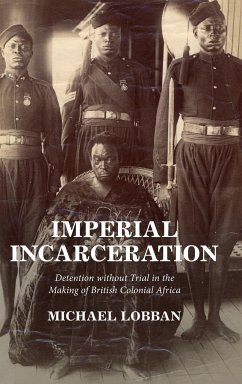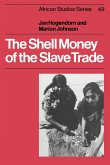Michael Lobban
Imperial Incarceration
Michael Lobban
Imperial Incarceration
- Gebundenes Buch
- Merkliste
- Auf die Merkliste
- Bewerten Bewerten
- Teilen
- Produkt teilen
- Produkterinnerung
- Produkterinnerung
A rich study exploring the use of detention without trial to facilitate imperial expansion of the British African Empire.
Andere Kunden interessierten sich auch für
![The Kongolese Saint Anthony The Kongolese Saint Anthony]() John Kelly ThorntonThe Kongolese Saint Anthony29,99 €
John Kelly ThorntonThe Kongolese Saint Anthony29,99 €![Women in Twentieth-Century Africa Women in Twentieth-Century Africa]() Iris BergerWomen in Twentieth-Century Africa31,99 €
Iris BergerWomen in Twentieth-Century Africa31,99 €![A Report of the Kingdom of Congo and of the Surrounding Countries A Report of the Kingdom of Congo and of the Surrounding Countries]() Duarte LopezA Report of the Kingdom of Congo and of the Surrounding Countries29,99 €
Duarte LopezA Report of the Kingdom of Congo and of the Surrounding Countries29,99 €![The Cambridge History of Africa The Cambridge History of Africa]() Roland Oliver / G. N. Sanderson (eds.)The Cambridge History of Africa82,99 €
Roland Oliver / G. N. Sanderson (eds.)The Cambridge History of Africa82,99 €![The Shell Money of the Slave Trade The Shell Money of the Slave Trade]() Jan HogendornThe Shell Money of the Slave Trade51,99 €
Jan HogendornThe Shell Money of the Slave Trade51,99 €![Democracy in Africa Democracy in Africa]() Nic CheesemanDemocracy in Africa30,99 €
Nic CheesemanDemocracy in Africa30,99 €![West African Studies West African Studies]() Mary KingsleyWest African Studies66,99 €
Mary KingsleyWest African Studies66,99 €-
-
-
A rich study exploring the use of detention without trial to facilitate imperial expansion of the British African Empire.
Hinweis: Dieser Artikel kann nur an eine deutsche Lieferadresse ausgeliefert werden.
Hinweis: Dieser Artikel kann nur an eine deutsche Lieferadresse ausgeliefert werden.
Produktdetails
- Produktdetails
- Verlag: Cambridge University Press
- Seitenzahl: 464
- Erscheinungstermin: 3. August 2021
- Englisch
- Abmessung: 235mm x 157mm x 32mm
- Gewicht: 899g
- ISBN-13: 9781316519127
- ISBN-10: 1316519120
- Artikelnr.: 62212379
- Herstellerkennzeichnung
- Libri GmbH
- Europaallee 1
- 36244 Bad Hersfeld
- gpsr@libri.de
- Verlag: Cambridge University Press
- Seitenzahl: 464
- Erscheinungstermin: 3. August 2021
- Englisch
- Abmessung: 235mm x 157mm x 32mm
- Gewicht: 899g
- ISBN-13: 9781316519127
- ISBN-10: 1316519120
- Artikelnr.: 62212379
- Herstellerkennzeichnung
- Libri GmbH
- Europaallee 1
- 36244 Bad Hersfeld
- gpsr@libri.de
Michael Lobban is a Professor of Legal History at LSE. He is the author of a number of notable works, including White Man's Justice: South African Political Trials in the Black Consciousness Era and A History of the Philosophy of Law in the Common Law World.
Acknowledgements
List of Maps
Abbreviations of Archival Sources
1. Introduction
1.1. Habeas Corpus and the Rule of Law
1.2. Martial Law 1.3. Legislating for Emergencies
1.4. Ad hominem Legislation
1.5. Emergency Law in East Africa
1.6. From 'Rule of Law' to 'Lawfare'
2. Martial Law and the Rule of Law in the Eastern Cape, 1830-1880
2.1. Four Wars and Two Rebellions
2.2. The Reach of Martial Law
2.3. Detention without Trial
2.4. Conclusion
3. Zulu Political Prisoners, 1872-1897
3.1. The Trial and Detention of Langalibalele
3.2. Cetshwayo's Capture and Detention
3.3. Dinuzulu's Trial and Exile
3.4. Conclusion
4. Egypt and Sudan, 1882-1887
4.1. The Exile of Ahmed Urabi Pasha
4.2. The Detention of Al-Zubayr Rahma Mansur
5. Detention without Trial in Sierra Leone and the Gold Coast, 1865-1890
5.1. The British Presence in West Africa
5.2. Detention without Legal Authority
5.3. Regularising Detentions
5.4. 'Peacekeping' Detentions in Sierra Leone
5.5. Political Detentions in the Gold Coast
5.6. Conclusion
6. Removing Rulers in the Niger Delta, 1887-1897
6.1. The British Presence in the Oil Rivers
6.2. Jaja of Opobo
6.3. Nana Olomu
6.4. Ovonramwen
6.5. Conclusion
7. Consolidating Colonial Rule: Detentions in the Gold Coast and Sierra Leone, 1896-1901
7.1. The Deposition of Prempeh of Asante
7.2. Sierra Leone's Hut Tax War and the Detention of Bai Bureh
7.3. Conclusion
8. Detention Comes to Court: African Appeals to the Courts in Whitehall and Westminster, 1895-1922
8.1. Sigcau, Sir Henry de Villiers and the Privy Council
8.2. Sekgoma Letsholathibe
8.3. Saad Zaghlul Pasha
8.4. Conclusion
9. Martial Law in the Anglo-Boer War, 1899-1902
9.1. The First Invasion, October 1899-October 1900
9.2. The Second Invasion, October 1900-March 1902
9.3. Ending Martial Law
9.4. Conclusion
10. Martial Law, the Privy Council and the Zulu Rebellion of 1906
10.1. Martial Law before the Rebellion, February-March 1906
10.2. Martial Law after Bambatha's Uprising, April-September 1906
10.3. Natal's Indemnity Act, the Privy Council and the Rule of Law
10.4. Tilonko's Deportation
10.5. Conclusion
11. Conclusion
Index.
List of Maps
Abbreviations of Archival Sources
1. Introduction
1.1. Habeas Corpus and the Rule of Law
1.2. Martial Law 1.3. Legislating for Emergencies
1.4. Ad hominem Legislation
1.5. Emergency Law in East Africa
1.6. From 'Rule of Law' to 'Lawfare'
2. Martial Law and the Rule of Law in the Eastern Cape, 1830-1880
2.1. Four Wars and Two Rebellions
2.2. The Reach of Martial Law
2.3. Detention without Trial
2.4. Conclusion
3. Zulu Political Prisoners, 1872-1897
3.1. The Trial and Detention of Langalibalele
3.2. Cetshwayo's Capture and Detention
3.3. Dinuzulu's Trial and Exile
3.4. Conclusion
4. Egypt and Sudan, 1882-1887
4.1. The Exile of Ahmed Urabi Pasha
4.2. The Detention of Al-Zubayr Rahma Mansur
5. Detention without Trial in Sierra Leone and the Gold Coast, 1865-1890
5.1. The British Presence in West Africa
5.2. Detention without Legal Authority
5.3. Regularising Detentions
5.4. 'Peacekeping' Detentions in Sierra Leone
5.5. Political Detentions in the Gold Coast
5.6. Conclusion
6. Removing Rulers in the Niger Delta, 1887-1897
6.1. The British Presence in the Oil Rivers
6.2. Jaja of Opobo
6.3. Nana Olomu
6.4. Ovonramwen
6.5. Conclusion
7. Consolidating Colonial Rule: Detentions in the Gold Coast and Sierra Leone, 1896-1901
7.1. The Deposition of Prempeh of Asante
7.2. Sierra Leone's Hut Tax War and the Detention of Bai Bureh
7.3. Conclusion
8. Detention Comes to Court: African Appeals to the Courts in Whitehall and Westminster, 1895-1922
8.1. Sigcau, Sir Henry de Villiers and the Privy Council
8.2. Sekgoma Letsholathibe
8.3. Saad Zaghlul Pasha
8.4. Conclusion
9. Martial Law in the Anglo-Boer War, 1899-1902
9.1. The First Invasion, October 1899-October 1900
9.2. The Second Invasion, October 1900-March 1902
9.3. Ending Martial Law
9.4. Conclusion
10. Martial Law, the Privy Council and the Zulu Rebellion of 1906
10.1. Martial Law before the Rebellion, February-March 1906
10.2. Martial Law after Bambatha's Uprising, April-September 1906
10.3. Natal's Indemnity Act, the Privy Council and the Rule of Law
10.4. Tilonko's Deportation
10.5. Conclusion
11. Conclusion
Index.
Acknowledgements
List of Maps
Abbreviations of Archival Sources
1. Introduction
1.1. Habeas Corpus and the Rule of Law
1.2. Martial Law 1.3. Legislating for Emergencies
1.4. Ad hominem Legislation
1.5. Emergency Law in East Africa
1.6. From 'Rule of Law' to 'Lawfare'
2. Martial Law and the Rule of Law in the Eastern Cape, 1830-1880
2.1. Four Wars and Two Rebellions
2.2. The Reach of Martial Law
2.3. Detention without Trial
2.4. Conclusion
3. Zulu Political Prisoners, 1872-1897
3.1. The Trial and Detention of Langalibalele
3.2. Cetshwayo's Capture and Detention
3.3. Dinuzulu's Trial and Exile
3.4. Conclusion
4. Egypt and Sudan, 1882-1887
4.1. The Exile of Ahmed Urabi Pasha
4.2. The Detention of Al-Zubayr Rahma Mansur
5. Detention without Trial in Sierra Leone and the Gold Coast, 1865-1890
5.1. The British Presence in West Africa
5.2. Detention without Legal Authority
5.3. Regularising Detentions
5.4. 'Peacekeping' Detentions in Sierra Leone
5.5. Political Detentions in the Gold Coast
5.6. Conclusion
6. Removing Rulers in the Niger Delta, 1887-1897
6.1. The British Presence in the Oil Rivers
6.2. Jaja of Opobo
6.3. Nana Olomu
6.4. Ovonramwen
6.5. Conclusion
7. Consolidating Colonial Rule: Detentions in the Gold Coast and Sierra Leone, 1896-1901
7.1. The Deposition of Prempeh of Asante
7.2. Sierra Leone's Hut Tax War and the Detention of Bai Bureh
7.3. Conclusion
8. Detention Comes to Court: African Appeals to the Courts in Whitehall and Westminster, 1895-1922
8.1. Sigcau, Sir Henry de Villiers and the Privy Council
8.2. Sekgoma Letsholathibe
8.3. Saad Zaghlul Pasha
8.4. Conclusion
9. Martial Law in the Anglo-Boer War, 1899-1902
9.1. The First Invasion, October 1899-October 1900
9.2. The Second Invasion, October 1900-March 1902
9.3. Ending Martial Law
9.4. Conclusion
10. Martial Law, the Privy Council and the Zulu Rebellion of 1906
10.1. Martial Law before the Rebellion, February-March 1906
10.2. Martial Law after Bambatha's Uprising, April-September 1906
10.3. Natal's Indemnity Act, the Privy Council and the Rule of Law
10.4. Tilonko's Deportation
10.5. Conclusion
11. Conclusion
Index.
List of Maps
Abbreviations of Archival Sources
1. Introduction
1.1. Habeas Corpus and the Rule of Law
1.2. Martial Law 1.3. Legislating for Emergencies
1.4. Ad hominem Legislation
1.5. Emergency Law in East Africa
1.6. From 'Rule of Law' to 'Lawfare'
2. Martial Law and the Rule of Law in the Eastern Cape, 1830-1880
2.1. Four Wars and Two Rebellions
2.2. The Reach of Martial Law
2.3. Detention without Trial
2.4. Conclusion
3. Zulu Political Prisoners, 1872-1897
3.1. The Trial and Detention of Langalibalele
3.2. Cetshwayo's Capture and Detention
3.3. Dinuzulu's Trial and Exile
3.4. Conclusion
4. Egypt and Sudan, 1882-1887
4.1. The Exile of Ahmed Urabi Pasha
4.2. The Detention of Al-Zubayr Rahma Mansur
5. Detention without Trial in Sierra Leone and the Gold Coast, 1865-1890
5.1. The British Presence in West Africa
5.2. Detention without Legal Authority
5.3. Regularising Detentions
5.4. 'Peacekeping' Detentions in Sierra Leone
5.5. Political Detentions in the Gold Coast
5.6. Conclusion
6. Removing Rulers in the Niger Delta, 1887-1897
6.1. The British Presence in the Oil Rivers
6.2. Jaja of Opobo
6.3. Nana Olomu
6.4. Ovonramwen
6.5. Conclusion
7. Consolidating Colonial Rule: Detentions in the Gold Coast and Sierra Leone, 1896-1901
7.1. The Deposition of Prempeh of Asante
7.2. Sierra Leone's Hut Tax War and the Detention of Bai Bureh
7.3. Conclusion
8. Detention Comes to Court: African Appeals to the Courts in Whitehall and Westminster, 1895-1922
8.1. Sigcau, Sir Henry de Villiers and the Privy Council
8.2. Sekgoma Letsholathibe
8.3. Saad Zaghlul Pasha
8.4. Conclusion
9. Martial Law in the Anglo-Boer War, 1899-1902
9.1. The First Invasion, October 1899-October 1900
9.2. The Second Invasion, October 1900-March 1902
9.3. Ending Martial Law
9.4. Conclusion
10. Martial Law, the Privy Council and the Zulu Rebellion of 1906
10.1. Martial Law before the Rebellion, February-March 1906
10.2. Martial Law after Bambatha's Uprising, April-September 1906
10.3. Natal's Indemnity Act, the Privy Council and the Rule of Law
10.4. Tilonko's Deportation
10.5. Conclusion
11. Conclusion
Index.








